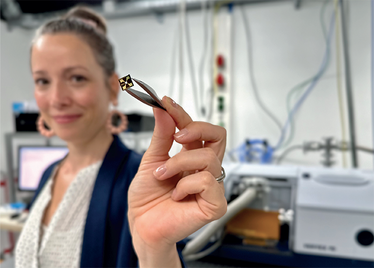Zooming In on Nanoplastics
How increased sensitivity of emerging technologies is improving nanoplastic detection
Josiane P. Lafleur, Jelena Timarac Popović | | 2 min read | Opinion

Photo credit: Tatjana Penn / Invisible-Light Labs GmbH
Nanoplastics, a subset of microplastic particles that are even smaller in diameter, are everywhere – from our soils to the air we breathe. Therefore, it is no surprise that researchers have found micro and nanoplastics in various animal species and in human blood (1,2,3,4,5). Polymer-based nanoparticles have a large surface-to-volume ratio, which can increase reactivity and cause interactions with dangerous substances and microorganisms. The toxicity of nanoparticles – alongside their ability to act as carriers for other pollutants – demands that we think cautiously about this issue (6,7,8,9,10).
If all that’s not alarming enough, scientists have recently discovered plastics in infants, breastmilk, and placenta (11,12,13) – a true wake-up call to find solutions.
The size of nanoparticles (1–100 nm) can make sampling and identification a real challenge; for example, sub-microplastics and nanoplastics have sizes below the limit of common microscopy hyphenated with spectroscopy techniques such as Fourier-transform infrared spectroscopy (FTIR), Raman microspectroscopy, and focal plane array (FPA)-FTIR (14). Atomic force microscope-infrared spectroscopy (AFM-IR), transmission electron microscopy with energy dispersive X-Ray spectroscopy (TEM-EDX), and scanning electron microscopy with energy dispersive X-ray spectroscopy (SEM-EDX) are three methods capable of chemical characterization of individual nanoparticles; however, the process is time-consuming, taking several hours to scan the filter’s surface.
At Invisible-Light Labs, we’re working on a system for nanoplastic analysis by collaborating with external research groups focused on detection of airborne and waterborne nanoplastics. We’ve come a long way since our initial conversations of the possible applications of infrared spectroscopy in environmental monitoring. The project I’m most excited about is our EIC-funded project NEMILIES (NanoElectroMechanical Infrared Light for Industrial and Environmental Sensing) which allowed us to develop EMILIE. EMILIE uses nanoelectromechanical Fourier-transform infrared spectroscopy (NEMS-FTIR) to provide rapid bulk chemical characterization of nanoplastics and sub-microplastics in the size range of 10–500 nm. Importantly, it uses a perforated nanoelectromechanical membrane as both a filter and a sensing element. This means that after sampling nanoplastics on the nanomechanical membrane, it can be directly transferred to the EMILIE detector chamber for FTIR analysis. With this method, we can achieve the required picogram level detection limits for nanoplastics analysis with minimal sample losses and contamination – we can also determine the absolute mass of the nanoplastics deposited on the membrane (15).
The NEMILIES project could solve several challenges environmental researchers continuously face – namely, by providing more than just the concentration or size distributions of nanoparticles, but instead by providing their physical and chemical properties. Indeed, one important piece of the nanoplastics puzzle is chemical fingerprinting. Without chemical identification, it’s very difficult to identify the source of pollution and remediate it. Based on this information, we can understand where the nanoparticles come from, their level of toxicity, their environmental fate, and how they interact with other particles.
As other scientists join our efforts in studying nano and microplastics, we’re sure to expand our knowledge for tackling this crisis. I’m excited to see where such technology can go with further efforts.
- HA Leslie et al., “Discovery and quantification of plastic particle pollution in human blood”, ScienceDirect, 163, 107199 (2022). DOI: 10.1016/j.envint.2022.107199.
- M Oliveria, M Almeida, “The why and how of micro(nano) plastic research”, ScienceDirect, 114, 196-201. DOI: 10.1016/j.trac.2019.02.023.
- M Cole et al., “Microplastic Ingestion by Zooplankton”, ACS Publications, 47, 12, 6646-6655 (2013). DOI: 10.1021/es400663f.
- AJR Watts et al., “Effect of Microplastic on the Gills of the Shore Crab Carcinus maenas”, ACS Publications, 50, 10, 5364-5369 (2016). DOI: 10.1021/acs.est.6b01187.
- C Ma et al., “Distribution and translocation of micro- and nanoplastics in fish”, Critical Reviews in Toxicology, 51:9, 740-753 (2021). DOI: 10.1080/10408444.2021.2024495.
- L Wang et al., “Environmental fate, toxicity and risk management strategies of nanoplastics in the environment: Current status and future perspectives”, Journal of Hazardous Materials, 401, 123415 (2021). DOI: 10.1016/j.jhazmat.2020.123415.
- S singh et al., “Micro (nano) plastics in wastewater: A critical review on toxicity risk assessment, behaviour, environmental impact and challenges”, ScienceDirect, 290, 133169 (2022). DOI: 10.1016/j.chemosphere.2021.133169.
- OH Fred-Ahmadu et al., “Interaction of chemical contaminants with microplastics: Principles and perspectives”, The Science of the total environment, 706, 135978 (2020). DOI: 10.1016/j.scitotenv.2019.135978.
- AA Koelmans et al., “Leaching of plastic additives to marine organisms” ScienceDirect, 187, 49-54 (2014). DOI: 10.1016/j.envpol.2013.12.013.
- SL Wright et al., “The physical impacts of microplastics on marine organisms: A review”, ScienceDirect, 178, 483-492 (2013). DOI: 10.1016/j.envpol.2013.02.031.
- J Zhang et al., “Occurrence of Polyethylene Terephthalate and Polycarbonate Microplastics in Infant and Adult Feces”, Environmental Science and Technology Letters, 8, 11, 989-994 (2021). DOI: 10.1021/acs.estlett.1c00559.
- A Ragusa et al., “Raman Microspectroscopy Detection and Characterisation of Microplastics in Human Breastmilk”, Polymers, 14, 13, 2700 (2022). DOI: 10.3390/polym14132700.
- A Ragusa et al., “Plasticenta: First evidence of microplastics in human placenta”, ScienceDirect, 146, 106274 (2021). DOI: 10.1016/j.envint.2020.106274.
- C Schwaferts et al., “Methods for the analysis of submicrometer- and nanoplastic particles in the environment”, ScienceDirect, 112, 52-65 (2019). DOI: 10.1016/j.trac.2018.12.014.
- N Luhmann et al., “Nanoelectromechanical Infrared Spectroscopy with In Situ Separation by Thermal Desorption: NEMS-IR-TD”, ACS Publications, 8, 4, 1462-1470 (2023). DOI: 10.1021/acssensors.2c02435.
Managing Director and Head Scientist at Invisible-Light Labs, Austria
R&D Engineer at Invisible-Light Labs, Austria

















